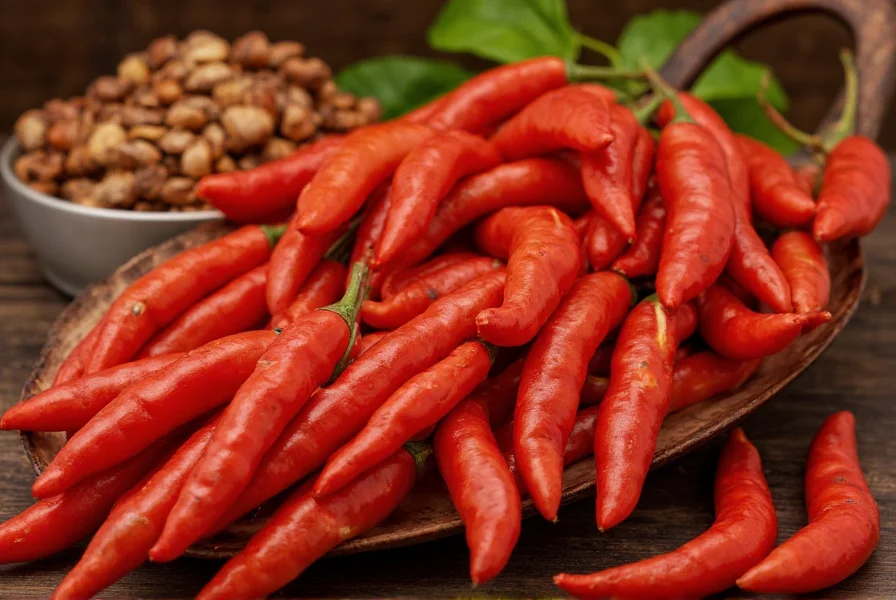When searching for “chili def,” you’re likely seeking a clear explanation of what chilies are. This comprehensive guide covers everything from botanical classification to culinary applications, helping you understand these versatile peppers that add flavor and heat to cuisines worldwide.
What Exactly Is a Chili Pepper?
Chili peppers belong to the Capsicum genus within the nightshade family (Solanaceae). Unlike black pepper (Piper nigrum), which produces piperine for heat, chilies contain capsaicinoids—primarily capsaicin—that stimulate thermoreceptor neurons, creating the characteristic burning sensation.
Botanically classified as berries, chilies develop from the ovary of a flower and contain seeds. They’re technically fruits, though culinary traditions treat them as vegetables. The highest concentration of capsaicin exists in the placental tissue surrounding the seeds, not the seeds themselves.
| Chili Type | Scoville Heat Units | Common Uses |
|---|---|---|
| Bell Pepper | 0 SHU | Salads, stuffed dishes |
| Jalapeño | 2,500–8,000 SHU | Salsas, nachos, pickled |
| Habanero | 100,000–350,000 SHU | Hot sauces, Caribbean cuisine |
| Carolina Reaper | 1,400,000–2,200,000 SHU | Extreme heat challenges |
Major Chili Varieties and Their Characteristics
Understanding chili varieties helps cooks select appropriate heat levels and flavors. Here’s what distinguishes popular types:
Common Mild Chilies (0–5,000 SHU)
Ancho chilies (dried poblanos) offer sweet, raisin-like notes perfect for mole sauces. Poblano peppers stay mild when fresh but develop complex flavors when roasted. Banana peppers provide tangy sweetness ideal for sandwiches and salads.
Medium-Heat Varieties (5,000–50,000 SHU)
Jalapeños dominate Mexican cuisine with their bright, grassy flavor. Serranos deliver sharper heat preferred in salsas verdes. Fresnos resemble red jalapeños but with fruitier notes, excellent for pickling.
Hot and Extreme Chilies (50,000+ SHU)
Habaneros and Scotch bonnets share tropical fruit notes beneath intense heat, essential in Caribbean and Yucatecan cooking. Ghost peppers (Bhut jolokia) and Carolina Reapers represent extreme heat levels requiring careful handling—often used in minute quantities for sauces.

Measuring Chili Heat: The Scoville Scale Explained
Wilbur Scoville developed his namesake scale in 1912 through human taste testing. Modern labs now use high-performance liquid chromatography (HPLC) to measure capsaicin concentration, converting results to Scoville Heat Units (SHU).
Understanding this scale prevents culinary disasters. A single habanero (100,000–350,000 SHU) equals approximately 40 jalapeños (2,500–8,000 SHU) in heat potential. When substituting chilies, always start with less than you think you need—you can add heat but can’t remove it.
Culinary Applications Across Global Cuisines
Chilies transformed global cooking after Columbus brought them from the Americas. Each culture developed distinctive applications:
- Mexican cuisine uses dried chilies like guajillo and ancho in complex mole sauces
- Thai cooking features bird’s eye chilies in curries and stir-fries
- Indian cuisine incorporates both fresh green chilies and dried red varieties
- Sichuan Chinese cooking employs Sichuan peppercorns alongside chilies for “ma la” (numbing spice)
- Hungarian paprika ranges from sweet to hot, essential in goulash
Professional chefs recommend toasting dried chilies before rehydrating to unlock deeper flavors. For fresh chilies, removing seeds and membranes significantly reduces heat while preserving flavor.
Nutritional Benefits of Chilies
Beyond heat, chilies deliver impressive nutritional value. Just one raw jalapeño (14g) provides:
- 9% of daily vitamin C needs
- 4% of vitamin B6
- 2% of vitamin A
- Trace amounts of potassium and magnesium
Capsaicin shows potential health benefits including pain relief through desensitization of nerve receptors, modest metabolic boost, and possible cardiovascular benefits. However, excessive consumption can cause gastrointestinal distress in sensitive individuals.

Growing Your Own Chilies: Basic Tips
Home gardeners can successfully grow chilies with these fundamentals:
- Start seeds indoors 8–10 weeks before last frost
- Provide 6–8 hours of direct sunlight daily
- Maintain soil pH between 6.0–7.0
- Water consistently but avoid soggy soil
- Harvest when peppers reach full color for maximum flavor
Container gardening works well for chilies, making them suitable for patios and balconies. Most varieties require 60–90 days from transplanting to harvest. Remember that stressors like inconsistent watering can increase capsaicin production, making peppers hotter than expected.
Common Misconceptions About Chilies
Several myths persist about these peppers. Contrary to popular belief, the seeds don’t contain the most heat—it’s the white pith surrounding them. Chilies don’t actually “burn” tissue; they trigger heat receptors that make your body think it’s burning.
Another misconception: all red chilies are hotter than green ones. Ripeness affects flavor more than heat—many chilies turn red when fully ripe but maintain similar Scoville ratings. The “chili” in chili con carne typically refers to the dish itself, not a specific pepper variety.
Frequently Asked Questions
What's the difference between chili, chile, and chilli spelling?
These are regional spelling variations. 'Chili' is common in the United States, 'chile' in Mexico and South America, and 'chilli' in British English. All refer to the same peppers from the Capsicum genus.
Why do chilies make your mouth feel hot?
Chilies contain capsaicin, which binds to TRPV1 receptors in your mouth that normally detect heat. This tricks your brain into thinking your mouth is burning, even though no actual thermal damage occurs.
How can I reduce the burning sensation from chilies?
Dairy products like milk or yogurt work best because casein breaks down capsaicin. Sugar or starchy foods like bread can help somewhat, but water spreads the oil-based capsaicin, making burning worse.
Are hotter chilies less flavorful?
Not necessarily. Many extremely hot chilies like habaneros have complex fruity or floral notes beneath the heat. Flavor depends more on variety than heat level, though excessive heat can overwhelm other flavor components.
Can you build tolerance to spicy foods?
Yes, regular consumption of capsaicin can desensitize TRPV1 receptors over time. This is why cultures with spicy cuisines often have higher tolerance levels. The effect is temporary though—if you stop eating spicy foods, your sensitivity returns.











 浙公网安备
33010002000092号
浙公网安备
33010002000092号 浙B2-20120091-4
浙B2-20120091-4